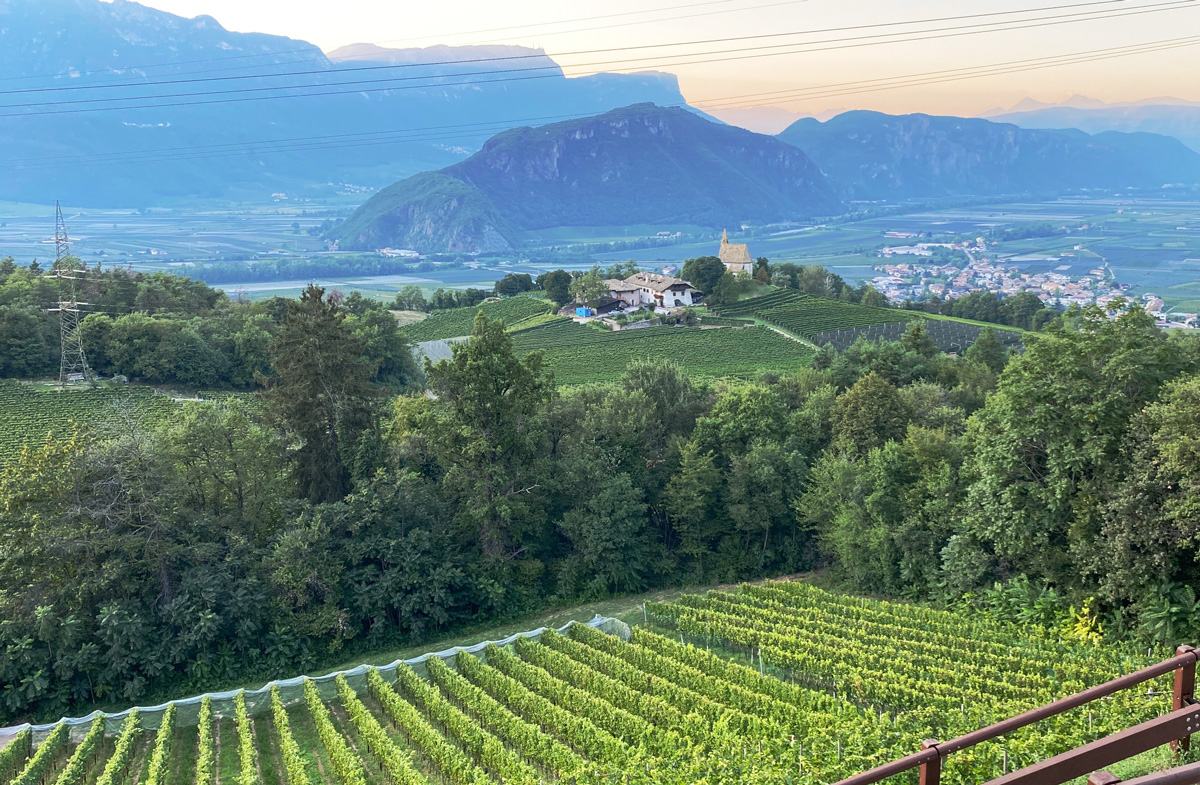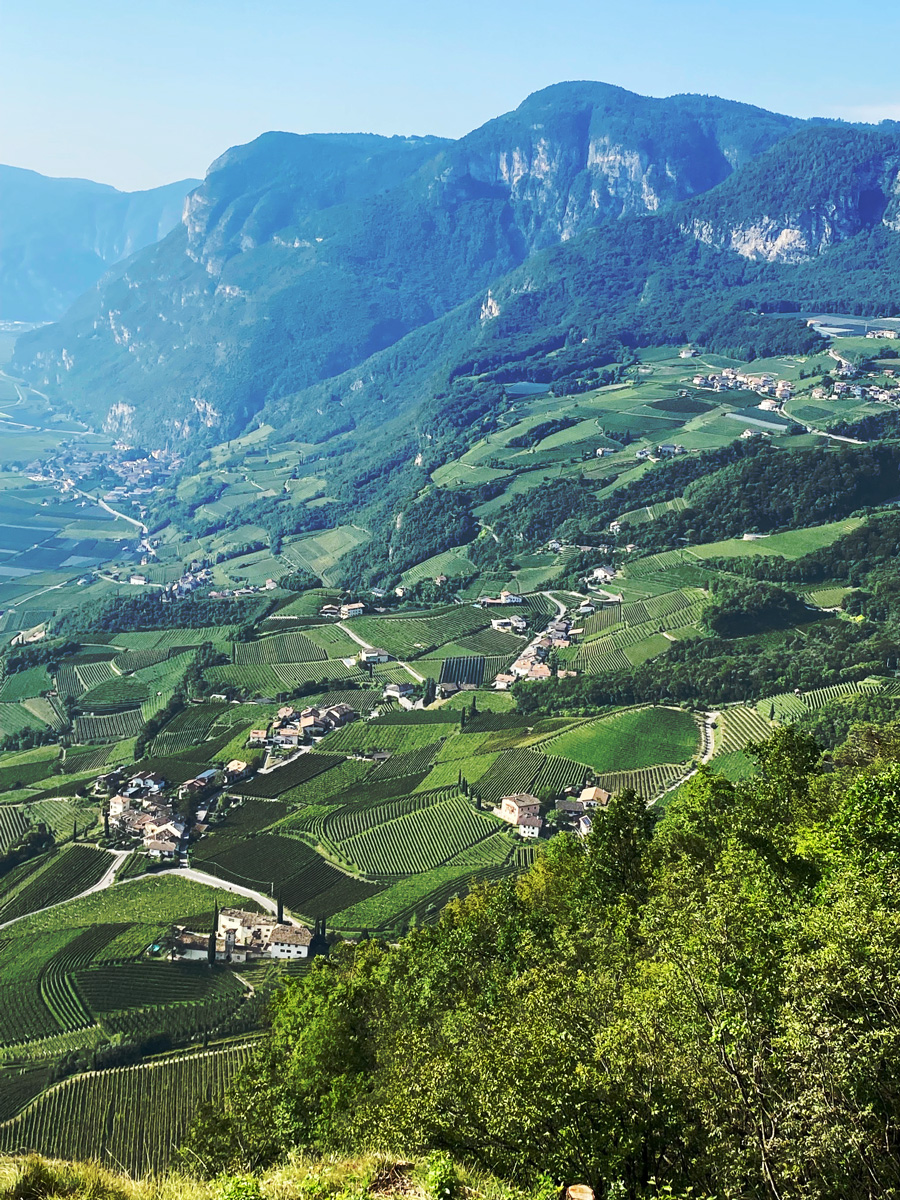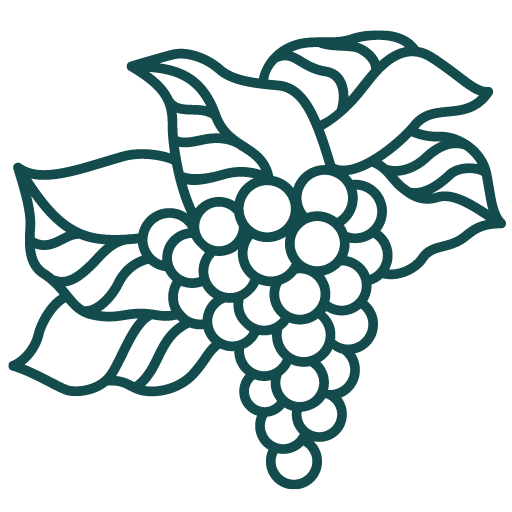
Wine Culture Magazine

Looking towards Bolazno from the tasting room patio at Pfitscher Winery.
“Alto Adige is unique in its harmony of opposites: the north and the south, the German-speaking and the Italian-speaking worlds, the snow-covered mountains and the fertile valleys along with an unbeatable Alpine-Mediterranean climate.” —Alex Ferrigato, Sales & Marketing Director, Cantina Colterenzio.
Located high up in the northeastern corner of Italy, Alto Adige is a unique wine region of contrasts, with a geography, geology, climate and history that make it a leader for quality wine.
Alto Adige boasts one of Europe’s oldest wine cultures, dating back to the fifth century B.C. Located in northern Italy, bordering Austria, it stretches north to south with a confluence of rivers, valleys and alps covering some 5,700 hectares. It boasts 274 family-run wineries and 5,000 grape growers. It’s at the climatic intersection of cool Continental and warm Mediterranean. The ancient terroir is diverse. Grape varieties are both indigenous and international.
Alto Adige represents less than one per cent of the total vineyard land in a country where vineyards span 708,000 hectares, ranking fourth globally. It produces 40 million bottles of wine annually, of which a remarkable 98 per cent is classified as denominazione di origine controllata (DOC), the highest classification in Italy.
Alto Adige’s wine community is a tapestry of small, family-owned vineyards, wineries and large co-operatives all working together. Sustainable farming practices and unwavering attention to detail are the reason these pristine vineyards are stunningly beautiful.
Alto Adige has been shaped over time, influenced by the Romans, the Habsburgs and First World War treaties. The Romans brought both manpower and grapes to the region. During the Renaissance, Bavarian and Swabian monasteries acquired wineries and expertise. This tradition continued under the Habsburgs, who invested in prized Bordeaux and Burgundy varieties in the 1900s.
Annexed by Italy after the First World War, the region retained its German language and culture, a duality that is reflected on wine labels, where grape varieties may appear as German “Grauburgunder” or Italian “Pinot Grigio.” Today’s wines of Alto Adige have emerged from a unique blend of Italian and German influences.

View from Cantina Kurtatsch vineyards at 900M.
Situated in northeastern Italy, Alto Adige borders Austria to the north, Switzerland to the northwest, Lombardy to the west and Veneto to the east. The region’s terrain varies from 200 to 1,000 metres in elevation, with northern mountains shielding the vineyards from cold, damp winds. Hailstorms are an issue, although 2023 has so far been spared. River valleys divide the region, with Isarco, Pusteria, Pizve, Brenata and Adige being the most significant. The southern town of Appiano, which sits along the Alto Adige Wine Road, is considered a central wine-growing area.
With over 1,900 hours of annual sunlight and daily winds from Lake Garda, vineyards remain free of mildew and pests. The diurnal temperature shift between warm days and cool nights helps grapes maintain high acidity levels, a distinctive trait of these wines. The diverse soils of Alto Adige are limestone, schist and porphyry, contributing mineral complexity while adding depth and character to the wines.
Terroir significantly influences grape selection and wine style in Alto Adige.
For instance, the Brixen Valley basin in the north, with its cooler temperatures and light moraine soils, favours Kerner, Sylvaner, Riesling and Grüner Veltliner, resulting in fresh and fruity wines.
Further south in Bozen (Bolzano), warm winds from Lake Garda heat up the valley, making its porphyry soils ideal for juicy Lagrein and spicy Schiava. Due to this unique terroir, grapes enjoy a longer ripening period, resulting in wines with excellent structure, balance and aging potential.
Alto Adige cultivates more than 20 grape varieties.
Approximately 64 per cent of vineyards are planted with white grapes. The leading varieties are Pinot Grigio, Chardonnay, Gewurztraminer, Pinot Blanc and Sauvignon Blanc. Whites offer precise aromas, fresh acidity with medium to full body, fine balance and elegant structure.
Red varieties make up the remaining 36 per cent, with an historical focus on Schiava (known locally as Vernatsch). Today, Schiava, Lagrein and Pinot Noir are the top plantings. Red wines from this region are typically light to medium-bodied, brimming with vibrant fruit flavours, perfect for a light chill, making them ideal for summer patios.
The 2022 vintage in Alto Adige was nothing short of exceptional. It yielded flawless, healthy grapes with desired sugar levels and slightly reduced acidity. The wines from this vintage are known for being full-bodied and rich, with powerful, mature fruit aromas.

Lush and healthy Vineyard at Cantina Colterenzio in September 2023.
With an average vineyard size of just one hectare, the region’s 5,000 vignerons support various co-operatives. Biodiversity is encouraged in the vineyard while chemical and synthetic weed killers and pesticides are forbidden. Manual labour fosters attention to detail. Grapes are hand-picked and yields are low. Drip irrigation helps reduce water usage.
“Our philosophy is to work in harmony with nature: this is why in the vineyards we use sustainable farming practices … and are respectful of the natural cycle of the vine.”
—Jakob Gasser, assistant winemaker, St. Michael-Eppan
Co-operatives like Colterenzio, near Appiano, emphasize sustainability, with a focus on reducing CO2 emissions. Investing in their facilities by implementing solar panels and heat recovery systems benefits both their bottom line and the environment. At Kellerei, St. Michael‑Eppan and Cantina Produttori, lightweight bottles sourced from nearby Trentino have replaced the traditional heavier ones, reducing their transportation emissions. Here in the Alto Adige co-operatives have a global reputation as high-quality producers.
In this tiny but mighty wine region, the combination of Alpine and Mediterranean terroir, German and Italian languages, and a history of grape growing and winemaking, creates a unique magic. Wines from Alto Adige offer mountain freshness, mineral texture and aromatic precision in Italy’s highest-quality region.
Do you love bubbles? Südtiroler Sekt (sekt is german for sparkling wine) is a DOC classification for traditional method sparkling wine in Alto Adige. Producing approximately 450,000 bottles annually, this high quality bubble is made from Chardonnay, Pinot Blanc and Pinot Noir grapes.

Alois Lageder 2020 Schiava (SKU 1028513)
100% Schiava. Stainless steel and concrete tanks. Fresh red fruit, violet and white pepper spice, on the palate, soft and dry. Certified Organic. Suits starters, pasta, pizza, white meats and poultry.

Kellerei Cantina Terlan “St. Magdalener” Lagrein 2021 (SKU 250475)
85% Schiava, 15% Lagrein. Neutral oak and stainless steel. Aromas of black elderberry and cherry underpinned by bitter almond and a nuance of violet. Balanced acidity and low tannin. Perfect with charcuterie, cream cheeses, roast beef with salsa verde and parsley potatoes.

Loacker “Tasnim” Sauvignon Blanc 2022 (SKU 444287)
100% Sauvignon Blanc. Neutral oak foudres and stainless steel. Aromas of tropical fruit, peach and apricot and floral with hints of daisies. Certified vegan, organic and biodynamic. Ideal with asparagus dishes, onion soup and grilled fish.

Kellerei St. Michael-Eppan “Montiggle” Riesling 2017 (SKU 444287)
100% Riesling. Dry, racy with mineral backbone, classic nose of citrus and stone fruit with long finish. Age-worthy. Suits rich cheeses and grilled sausages.

Vitis is is an indispensable seasonal guide for vintners, sommeliers and weekend imbibers alike that is dedicated to British Columbia’s rapidly evolving wine culture.

Vitis is is an indispensable seasonal guide for vintners, sommeliers and weekend imbibers alike that is dedicated to British Columbia’s rapidly evolving wine culture.
Copyright © 2025 - All Rights Reserved Vitis Magazine